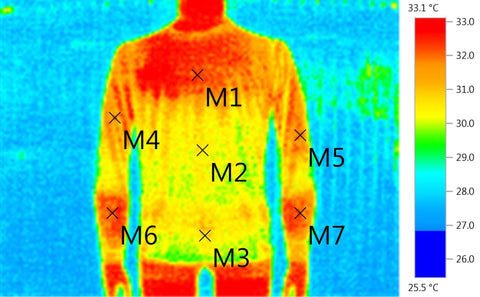QMax Cool – Intelligent Fabric Cooling
Posted by Leah Li on
The mean body temperature of humans is 37+/-0.5’C, and during physical exercise the body produces high heat in the range of 800–1300W, which if not managed well can lead to high discomfort.
Our body has 2 natural responses to adjust its body temperature :
1. Moisture Regulation – Sweating removes upto 65% of body temperature
2. Thermal Regulation – Excess heat is removed from the body by Conduction, Convection and Radiation.
Hence, sweat absorbing, fast drying, and cooling are the key functional requirements for high-activity sports clothing.
Currently the activewear industry has very well addressed the concerns of Moisture regulation through Wicking and Quick Drying fabrics, but solutions for Thermal Regulation are gaining importance as well, as consumers demand better comfort levels.
Further touch is a critical attribute in defining the quality of fabric. The clothes we wear defines our relationship with the fabric if it is comfortable, pleasant to touch and can give us the comfort we desire. Human skin has a natural ability to detect the warmth and coolness of a fabric. This distinctness of how a fabric feels on touch, whether it’s warm or cool is measured through Q-max.
For better heat transmission, the fabric needs to have a high conductivity.
Specifically when it comes to Sportswear, it becomes more important as the body is producing high heat and sweat. In hot situations, sportswear should allow the wearer to stay cool; while in cold situations, sportswear should help the wearer to stay warm.
So the sportswear garments should enable this heat to be transferred easily to the environment, helping the body to stay comfortable.
How does Thermal Regulation work ?
Heat is transferred through Conduction, Convection and Radiation properties. Lets understand here, how it applies in the context of apparels.

1. Conduction – As the garment is in direct contact with the body, a fabric with a high heat Conduction rate (QMax value) can help transfer the excess heat quickly from the Body to the outer surface. This is more appropriate in Sportswear, as when the garment is wet due to sweating, the water causes more heat loss than air, and hence helps the body cool down faster. It is also important to know that the body regulates heat through specific heat zones in the body, where there is higher concentration of sweat glands like palms, under arms, chest, groins, etc. While looking at an Infrared image, the Red/ Orange zones are the ones from where more Heat is generated. Hence in Sports, it is important to conduct the heat from these heat zones to the overall garment, for faster cooling.
Body Temperature (Infrared Image) (Before Workout) (After Workout)


2. Convection – Garments are designed with air vents (using meshes) or designed to be loose fitted and airy, so that the Convection properties can allow the movement of air to cool down the body.
3. Radiation – If the outside temperature is lower than the body temperature, then the heat loss will happen due to radiation as well.
What is Q-max exactly?
Qmax is a value used to assess the warm or cool sensation of the material surface of a fabric. It indicates a warm or cool sensation when fabric comes in contact with the surface of the skin. The surface of the material is thereby important in defining how warm or cool the fabric feels to an individual. A high Qmax value would mean there is constant transfer of heat from the body to the surface of the material, which ensures a cooler feeling fabric. Simply saying, the Cooling function is activated by rising body temperature and deactivated once your body comes to normal state.
Why is this important?
Due to rapid changes in the climate, environmental pollution and the strenuous sunlight the people feel the discomfort caused by the higher temperature and humid weather. Further in applications of Activewear, where we are sweating it out either in the gym or on the field, fabrics with Cooling, Anti-UV, Thermal regulation, moisture transfer and water absorption etc. functions have become the preferred choice for the clothes we wear. The function of QMax is not only being used in Sports Apparels, but gaining importance in applications like Work wear, Casual Wear, and Home textiles (duvets, pillows, home textiles, etc) as well. There are a number of Japanese, German, Chinese, brands offering QMax Cooling products under the branding of brrr’, Luxear, Top Cool, Arc Chill, Cool Lite, etc. in all categories. Looking at the benefits of this function, and as people get more aware, it is sure to become a need for all. Fabrics which have a high QMax value, provide a cooling sensation to the skin and minimise sweating.
How is Q-max measured?
The Q-max value was introduced in the early 1980’s as a measure of predicting warm/cool feeling of fabrics by Kawabata and his team in Japan. According to technical standard of Japanese textile institute BOKEN, any fabrics providing 0.1w/cm2 of heat dissipation qualify for Q-Max Cool. It measures the rate of heat transfer through the material in Dry and Wet state. The results achieved on testing of various fabrics shows below results :

For this experiment a Polyester Knitted fabric having Hexarel Finish shows how Graphene conducts heat very efficiently, giving the fabric a Qmax Cool rating of 0.15w/cm2(Dry) and 0.37w/cm2(Wet). It enables the fabric to be cooler, when it is dry or wet, and helps transfer the body heat to the environment quickly. Comparatively other Poly, Nylon and Cotton fabrics show a much lesser QMax value, and would be less effective in thermal conductivity. Due to excess sweating players also have a possibility of Thermal Shocks, caused by continued heat loss due to their wet clothes after their high performance activity. So thermal and sweat regulation play a vital role.
Share this post
- 0 comments
- Tags: Sleep
